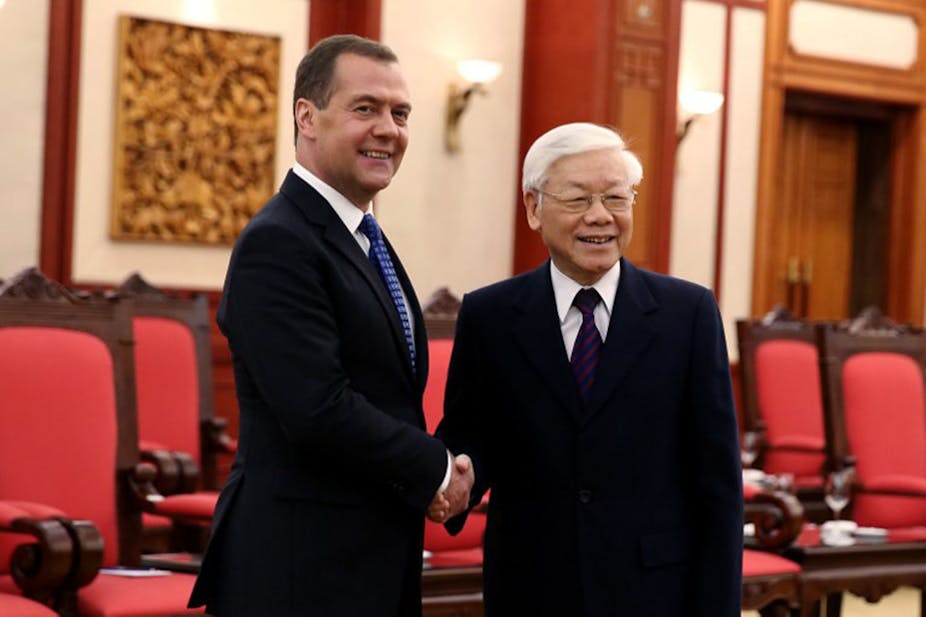On February 5, 2019, US President Donald Trump announced that he would meet North Korea’s Kim Jong Un for the second time, on February 27-28, in Vietnam. The reasons for the country’s offer are both economic and political. If the Kim-Trump summit goes well, Vietnam will have a new position on the world map, and political issues that affect it will attract more attention from the international community.
In particular, recent territorial disputes in the South China Sea -– which Vietnam refers to as the “East Sea” – have been complicated. China, Taiwan, Vietnam, the Philippines, Malaysia, Brunei and Indonesia all offer historical evidence to prove their sovereignty, in a region where border agreements are often unclear. Because of this issue, the relationship between Vietnam and China has grown tense.
Among other imperatives, China wants to secure its borders. In the north and west, China obtained “peace” with Mongolia (since 1919) and Tibet (more recently), and still tries to settle its border with Central Asia (Xinjiang and the Sino-Kyrgyz area). In the east, there are still sovereignty disputes with Japan and Korea over a number of islands, and of course there is the question of Taiwan, which from Beijing’s point of view is a part of China. In the south, Vietnam and the South China Sea questions have put a range of issues on the table: territorial waters, resources, control of trade roads and security – and especially pushing back US influence in what China sees as its “neighbourhood” (see map).
Vietnam’s situation is not unlike that of North Korea: it has to demonstrate a constructive attitude toward China and at the same time assert its diplomatic and strategic independence from Beijing. China, within the framework of its grand strategy, is prone to consider its immediate environment a mean of integration or, to say it more directly, a collection of semi-vassal states; situation it tries to enforce by both political and economic means.
When you have many “big friends”
For more than 100 years, Vietnam has managed to take advantage of the support of many countries, and the South China Sea disputes are no exception. In the Indochina war (1946-1954), Vietnam received direct aid from China and the Soviet Union, and this continued during the US-led Vietnam war (1955-1975).
Nevertheless, “making friends with giants” has never been easy for Vietnam. For example, in the Sino-Vietnamese war (1979), Moscow, which at that moment was still in a very close relationship with Hanoi, chose to not intervene directly. This war was both a “test” of China for the Soviet-Vietnamese relation and an opportunity to “attract” the United States to counter the USSR in this region.
With regards to the current South China Sea issue, an unprecedented degree of warmth in between Russia and China has forced Vietnam to seek a new “friend”, and the United States seems to be a reasonable choice.
Support of the international community also plays a very important role. When Malaysia Airlines flight MH370 disappeared in 2014, Vietnam was the first country to mobilise a large search force. These search-and-rescue operations are both the international responsibility and the declaration of sovereignty of Vietnam in the South China Sea.
However, the issue is more complicated than it seems to be. Vietnam opposes China’s expansion in the South China Sea but has to maintain a good relationship with its big neighbour, based on 16 “golden words” that can be translated as follows: “friendly neighbourhood, comprehensive cooperation, durable stability and future-oriented vision”. In the history of Vietnamese feudalism, the country defeated China a number of times, yet still sent its ambassadors to Beijing to reconcile, aimed at long-term peace.
Old “neighbour” or new “friend”
After the sudden departure of President Tran Dai Quang in 2018, the General Secretary of Vietnam Communist Party, Nguyen Phu Trong, concurrently held two positions. As both head of the ruling Communist Party and head of state, he can be officially invited to visit other countries, and selecting the first one is problematic. His first official foreign visit as head of state will be full of significance.
Based on the actual situation, Vietnam would like to organise a meeting with the United States to seek more support on the South China Sea issues, but on the other hand, Hanoi does not want to offend Beijing, as China and the US are engaged in a very intense trade war and the military presence of the US in the South China Sea makes China feel uncomfortable.

According to BBC Vietnam, the upcoming meeting between the US and North Korea seems to be a solution to break the deadlock. Hanoi will be able to hold a side meeting between Donald Trump and Nguyen Phu Trong to discuss the issues about which both countries are concerned, and Beijing will have no reason to protest this. In addition, Nguyen Phu Trong finally paid a visit to Laos and Cambodia (February 24-26, just before the summit), as a secure and peaceful solution.
Obviously, in the current world situation when the “game” of superpowers is constantly changing, countries like Vietnam must be very skillful to not be dragged into it and should both guarantee their legal rights and interests and enhance international prestige. More than before, “friendship” is replaced by “common interests” due to the main engine of international relations.

